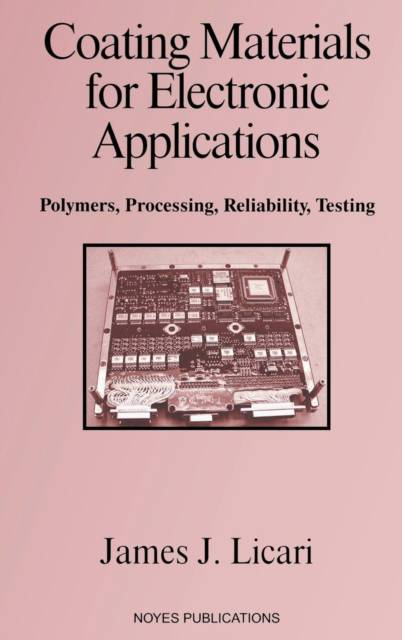
- Retrait gratuit dans votre magasin Club
- 7.000.000 titres dans notre catalogue
- Payer en toute sécurité
- Toujours un magasin près de chez vous
- Retrait gratuit dans votre magasin Club
- 7.000.000 titres dans notre catalogue
- Payer en toute sécurité
- Toujours un magasin près de chez vous
Coating Materials for Electronic Applications
Polymers, Processing, Reliability, Testing
James J Licari
424,45 €
+ 848 points
Description
This first book in the Materials and Processes for Electronics Applications series answers questions vital to the successful design and manufacturing of electronic components, modules, and systems such as: - How can one protect electronic assemblies from prolonged high humidity, high temperatures, salt spray or other terrestrial and space environments?- What coating types can be used to protect microelectronics in military, space, automotive, or medical environments?- How can the chemistry of polymers be correlated to desirable physical and electrical properties?- How can a design engineer avoid subsequent potential failures due to corrosion, metal migration, electrical degradation, outgassing?- What are the best processes that manufacturing can use to mask, clean, prepare the surface, dispense the coating, and cure the coating?- What quality assurance and in-process tests can be used to assure reliability?- What government or industry specifications are available?- How can organic coatings be selected to meet OSHA, EPA, and other regulations? Besides a discussion of the traditional roles of coatings for moisture and environmental protection of printed circuit assemblies, this book covers dielectric coatings that provide electrical functions such as the low-dielectric-constant dielectrics used to fabricate multilayer interconnect substrates and high-frequency, high-speed circuits. Materials engineers and chemists will benefit greatly from a chapter on the chemistry and properties of the main types of polymer coatings including: Epoxies, Polyimides, Silicones, Polyurethanes, Parylene, Benzocyclobenzene and many others. For manufacturing personnel, there is an entire chapter of over a dozen processes for masking, cleaning, and surface preparation and a comprehensive review of over 20 processes for the application and curing of coatings including recent extrusion, meniscus, and curtain coating methods used in processing large panels. The pros and cons of each method are given to aid the engineer in selecting the optimum method for his/her application. As a bonus, from his own experience, the author discusses some caveats that will help reduce costs and avoid failures. Finally, the author discusses regulations of OSHA, EPA, and other government agencies which have resulted in formulation changes to meet VOC and toxicity requirements. Tables of numerous military, commercial, industry, and NASA specifications are given to help the engineer select the proper callout.
Spécifications
Parties prenantes
- Auteur(s) :
- Editeur:
Contenu
- Nombre de pages :
- 545
- Langue:
- Anglais
- Collection :
Caractéristiques
- EAN:
- 9780815514923
- Date de parution :
- 31-12-03
- Format:
- Livre relié
- Format numérique:
- Genaaid
- Dimensions :
- 162 mm x 231 mm
- Poids :
- 1002 g







